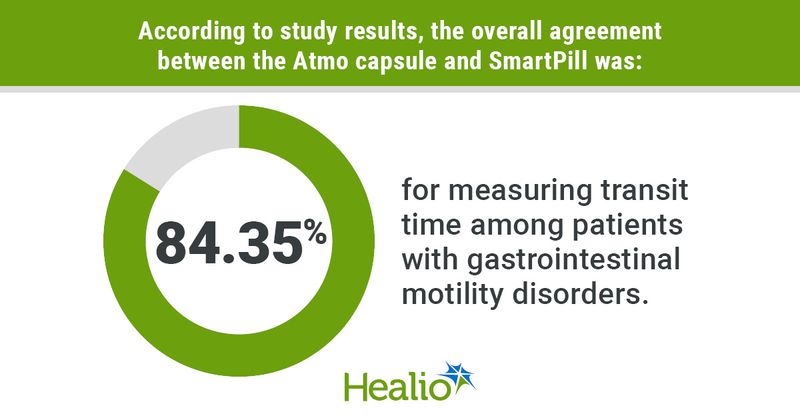Atmo capsule may offer ‘potential replacement’ for nixed SmartPill in motility disorders
Key takeaways:
- Transit time measurements were consistent between the Atmo Gas Sensing Capsule and Medtronic’s SmartPill.
- The Atmo capsule showed multiregional dysmotility in 18% of patients.
PHILADELPHIA — An ingestible gas-sensing capsule from Atmo Biosciences showed “substantial agreement” with the discontinued Medtronic wireless motility device for measuring regional transit times in gastrointestinal motility disorders.
Medtronic’s SmartPill capsule had previously been used to monitor gastric emptying time and colonic transit time pressure in patients with motility disorders. However, after the SmartPill was discontinued in July 2023 due to supply chain issues, there has been no comparable FDA-approved alternatives on the market.

“[The Atmo Gas Sensing Capsule] is a new technology for the measurement of whole and regional GI transit, and a replacement wireless motility capsule for the discontinued Medtronic SmartPill for the evaluation of motility disorders,” Braden Kuo, MD, MSc, FACG, director of the Center for Neurointestinal Health at Massachusetts General Hospital, told Healio.
To assess the effectiveness of the Atmo capsule against Medtronic’s SmartPill, Kuo and colleagues enrolled patients with upper, lower or combined GI symptoms (n=213) to concomitantly ingest both devices within 15 minutes of one another. However, four patients were reportedly unable to ingest both capsules within that window of time, leaving 209 patients included in the analysis.
The researchers measured regional transit times, including gastric emptying time (GET) and colonic transit time (CTT), for both devices; if GET lasted more than 5 hours or CTT more than 59 hours, transit time was considered delayed. Among the 209 patients, researchers used evaluable data for analysis from 177 with paired GET results and 147 with CTT results.
According to study results, time measurements for gastric emptying and colonic transit were consistent between the Atmo capsule and SmartPill, with both devices capable of identifying gastroduodenal and ileocaecal junctions in 93% of patients.
“For the evaluable population, 20% had delayed CTT only, 11% had delayed GET only and 18% had a delay in multiple GI regions as measured by [the Atmo Gas Sensing Capsule],” Kuo told Healio.
The researchers reported that the Pearson correlation coefficient for GET was 0.86 (0.81-0.89) and 0.74 (0.66 – 0.81) for CTT. When examining agreement between the Atmo capsule and SmartPill for measuring transit time, they found the positive predictive value for GET was 78%, negative predictive value was 85.83% and overall agreement was 83.62%; for CTT, positive predictive value was 67.35%, negative predictive value was 92.89% and overall agreement was 84.35%.
The researchers noted that the Atmo capsule provided more reliable detection when exiting the body due to its longer battery life compared with SmartPill (10 days vs. 5 days).
Kuo and colleagues did not report any serious adverse effects related to the devices.
“The Atmo Gas Sensing Capsule exhibited substantial agreement with the SmartPill in measuring both GET and CTT, highlighting its utility as a potential replacement for the discontinued wireless motility capsule for assessment of motility disorders,” Kuo said. “Additionally, [our findings] emphasize that multi-regional dysmotility is something that should be considered when treating patients with suspected motility disorders.”

